Medicinal plants can be found in the wild, in a city flower bed and even in a flowerpot on a windowsill. Many herbs, flowers, trees are capable of accumulating substances useful for the body, and some can replace modern medicines. But any plants should be used only after comparing with the photo and studying the description. Not all of them are equally useful and safe.
Record content:
- 1 Aloe
- 2 Ledum
- 3 Valerian
- 4 Bird highlander
- 5 Oregano
- 6 Blackberry gray
- 7 Ginseng
- 8 St. John's wort
- 9 Willow
- 10 Calendula
- 11 Lavender
- 12 Lungwort
- 13 Forget-me-not
- 14 Dandelion
- 15 Plantain
- 16 chamomile
- 17 Pine
- 18 Yarrow
- 19 Celandine
- 20 Sage
- 21 Tribulus
- 22 Videos about medicinal plants
Aloe
The second name of a familiar home plant is Centenary. Its flowers are said to appear once every 100 years. But this is not entirely true. In the homeland of aloe, in the African desert, it blooms every year. When grown indoors, it is difficult to create suitable conditions, which is why flowers are rarely seen.
In South Africa, aloe plants grow up to 5 meters, but in a room they rarely exceed 1 meter. Its leaves are long, like swords, smooth on the outside and have hard outgrowths in the form of spines at the edges. The inside contains a juicy gel-like mass that allows the aloe to survive the drought.
The greenish leaves contain, among other valuable ingredients, the unique compound aloin.
The substance is responsible for the following properties of aloe:
- improves digestion;
- kills germs;
- heals wounds;
- heals a runny nose.
For the treatment of abscesses, abscesses or cuts, it is enough to cut off the hard skin from the sheet and apply it to the damaged area. For oral administration, the bitter pulp is diluted with honey, or used in other mixtures. Such drugs strengthen the immune system, treat the stomach.
Ledum
A medicinal evergreen plant that prefers swampy areas. Photos and descriptions of this herb should be studied especially carefully. A plant with an intoxicating odor contains substances that are dangerous in large quantities. The rosemary scent can cause headaches, and internal intake must be limited to strict guidelines.
From the branched root system of wild rosemary, numerous stems with hard leaves resembling flat needles rise upward. The leaves are dark green above, slightly tucked on the back, covered with a rusty bloom. Each stem ends with an inflorescence in the form of a small umbrella.
The flowering tops, along with the leaves, are used for coughs caused by a variety of diseases. A decoction or tea from wild rosemary is used to treat bronchitis, pneumonia, whooping cough. Hot drinks with herbal added to relieve high temperatures. In the pharmacy, you can find the drug Ledin from wild rosemary, which suppresses coughing attacks.
Valerian
A herb that is used in folk and official medicine as a safe sedative. It is sometimes called "cat root" because the scent of the plant has an intoxicating effect on cats. Valerian grows throughout Europe and Asia, except for the deserts and the harsh climate of the Arctic. The plant loves wet places near water bodies, swamps, and is found in forests.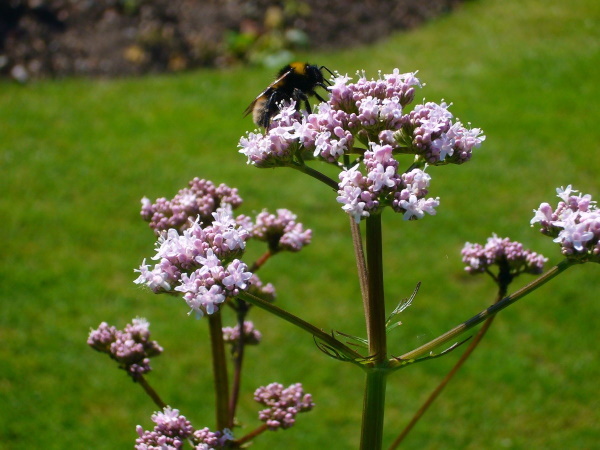
Valerian is a tall, perennial herb, sometimes its straight shoots rise up to 2 meters in height. At the tops of the stems, inflorescences bloom in the form of large, fluffy umbrellas. Flowers can be snow white or pink. The bluish leaves are mainly concentrated in the lower part of the plant.
The main property of Valerian is a sedative (sedative) effect. In this case, the active substances accumulate in the roots. Flowers and grass are practically not used. The rhizomes of adult plants are dug up, washed and dried, and then teas, infusions and tinctures are prepared.
I advise Valerian to drink with nervous excitement, insomnia, muscle tension, headaches. Tea or pharmaceutical preparation from the roots relieves abdominal cramping pains.
Bird highlander
A common weed that appears on paths, trampled fields, along fences. The herb has many other names - knotweed, goose grass, bird buckwheat, ant grass. Found on all continents except Antarctica and the Arctic.
An annual, surprisingly resistant plant, it has long stems that grow up to 80 cm in length and highly branch. Shoots do not rise high above the ground, but form lush thickets with a layer of up to 30 cm. The leaves of knotweed are small, round, green with a gray tint. Flowers are small, 2-3 pieces grow from the axils of each leaf.
The most valuable property of ant herb is the quick healing of wounds and cuts. For urgent help, it is enough to knead a few twigs of Knotweed and apply to damaged skin. The herb simultaneously stops bleeding, soothes pain and helps to heal even complex, deep injuries faster.
Oregano
A plant that can be seen as a decoration in the garden or as a spice on the kitchen shelf. Many people know Oregano as the aromatic Oregano seasoning characteristic of Italian cuisine. A perennial from the Yasnotkov family goes well with fish, meat, pickles, it is added to tea.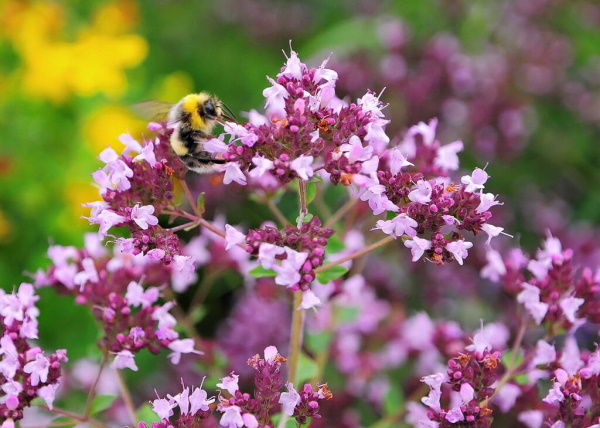
Oregano grows in forests and herb meadows, and can be grown in a garden bed or in a pot. The grass has many popular names: Matryoshka, Materinka, Forest mint, Ladanka.
The grass grows no higher than 70 cm, usually about 30 cm. In appearance, Oregano resembles mint, but with small leaves and a brighter color. Motherinka blooms with purple flowers collected in panicles.
Oregano (oregano) properties when added to food or tea leaves:
| For the stomach | Increases appetite, improves digestion, is used in the treatment of anorexia |
| For the nervous system | Helps to overcome stress, relax, promote sleep and sound sleep |
| For skin and mucous membranes | Relieves inflammation and heals rashes. As a gargle, relieves toothache |
This supplement increases appetite, improves digestion, and is used in the treatment of anorexia. Oregano tea helps to calm down and fall asleep in the evening.
Blackberry gray
Medicinal plants, photos and descriptions of which are herbs, trees or bushes, often have very valuable fruits for health. Blackberries are one of those natural medicines. Although the blackberry is more like a herb, it is a shrub with hardening thin branches.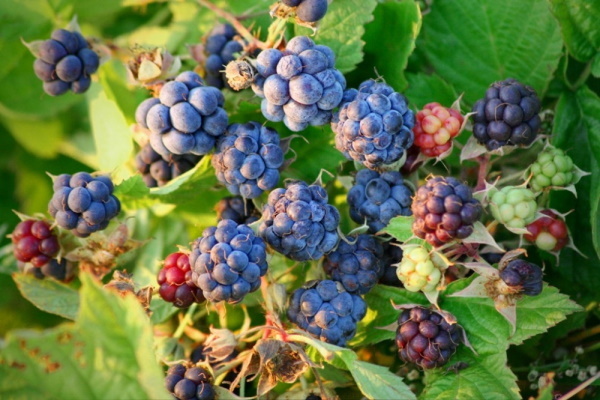
The plant belongs to the Rosaceae family. The stems and leaves of blackberries do look like rose bushes, but are smaller and tend to creep along the soil or climb a support. They also have thorns, and the flowers resemble small rose hips.
Berries - complex drupes - consist of several dark purple spherical fruitlets. You can meet blackberries in forest thickets, over ravines, sometimes in fields planted with grain crops.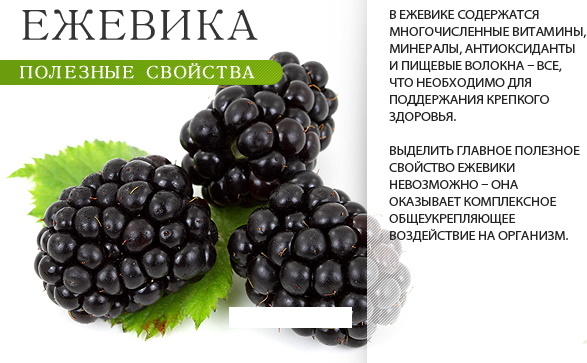
Ripe blackberries are used as food like any garden berries. Their ability to increase the separation of sweat, relieve fever, helps in the treatment of colds, flu, any conditions with a high body temperature. Unripe fruits have a bonding effect on the intestines. Ripe blackberries can be dried along with the tops and used to brew medicinal and vitamin teas all year round.
Ginseng
The roots of an amazing plant resemble a human body: they have paired branches in the form of arms and legs, and you can often see the semblance of a head. As a natural immunostimulant, ginseng was used 4 thousand years ago.
The Chinese consider it a miraculous remedy for all diseases, which gave the plant the generic name Panax, from the Greek word for "panacea". Earlier in Asia, the root was worth its weight in gold and was called the "Medicine of the Emperor".
Ginseng is a herbaceous, perennial plant with a height of about 30 cm with small umbellate flowers of yellow-green color. Its root grows slowly, reaching 25 cm over the years. Plants are usually used no earlier than 5 years of age.
Ginseng root fills a person with energy, improves immunity, and helps the body to overcome the most serious diseases. It is believed that tinctures or teas from the plant preserve youth for a long time, protect the heart, and treat depression. In addition, taking a natural bio-stimulant has a good effect on digestion.
St. John's wort
The origin of such a strange name is explained in different ways. But the most likely reason for the name is the influence of the plant on some animals. Cows, sheep, and other herbivores with white wool grazing in sunny areas begin to get sick after eating St. John's wort. Scientists attribute the effect to the influence of sunlight, and the grass only makes the body vulnerable.
The short plant is strewn with bright yellow flowers in summer. The open buds consist of 5 petals and many long stamens in the center. The leaves are very bright, green, in some species with dark spots of glands. Such varieties are also called Hypericum perforatum.
Medicinal plants, photos and descriptions of which are in official and folk medicine, are used to help with such conditions:
- depression or stressful experiences;
- cough, runny nose, viral diseases;
- stomach cramps, intestinal colic;
- infected, purulent wounds;
- liver disease.
But most of all, St. John's wort is in demand as a remedy for nervous disorders. There are several herbal preparations in pharmacies. Some of them (for example, Negrustin) are prescribed for children from 12 years old.
Willow
A spreading tree that can be found throughout Europe and Asia, excluding only the Far North. Plants form groves or grow singly along the banks of water bodies, on slopes, embankments, in mountainous terrain. Willows are often used for landscaping squares, parks, city gardens.
But the plant is famous for its medicinal properties. Through the use of willow bark in folk healing, doctors discovered the compound salicin.
Salicylic acid tablets (Aspirin), as well as salicin in the bark of a plant, have the following properties:
- relieve pain;
- suppress inflammatory processes;
- knock down body temperature;
- reduce joint pain.
The first Aspirin was synthesized from willow plant raw materials.
A powerful tree can rise above 25 meters, and reach 5 meters in girth. Long-lived willows over 100 years old were found. Long, flexible branches can grow up to 3 meters.
Calendula
Bright orange flowers growing in nature and in flower beds are of great value in cosmetology, medicine, and are also used in cooking for coloring dishes. Another name for calendula is medicinal marigold.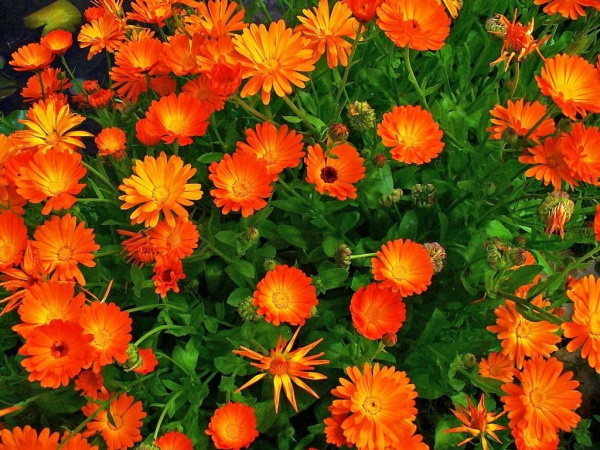
A low herbaceous plant tolerates different conditions very firmly and is capable of blooming before the onset of 5-degree frosts. The leaves of the annual are bright green, juicy, elongated at the tops, hugging the stems. Shoots are thick, ribbed, with good care they rise to a height of 70 cm. Leaves and stems are covered with coarse hairs.
Calendula flowers resemble large daisies. Only the marigolds are completely colored bright yellow, orange or brick red. The collected buds can be consumed as tea. The pharmacy has tinctures, calendula oil, and dried flowers for self-preparation of infusions.
Medicinal properties of calendula:
- calms the nervous system;
- kills some types of bacteria;
- reduces rashes, heals acne. purulent lesions;
- disinfects and heals wounds.
Pharmacy tincture treats problem skin, boils, treats calluses and remove warts. Infusion of calendula gargle with colds.
Lavender
Medicinal plants, photos and descriptions of which can be found in the medical literature, often decorate city flower beds, private gardens, courtyards. Lavender is one such plant. It is loved by gardeners and designers, cosmetologists, perfumers, and traditional healers highly appreciate it.
A strong, pleasant aroma of lavender is provided by special oils in the composition. For the valuable ether with a characteristic scent, lavender is grown in whole fields. The scent of flowers is considered an excellent sedative, it helps to fall asleep in the evening and relieve nervous tension during the day.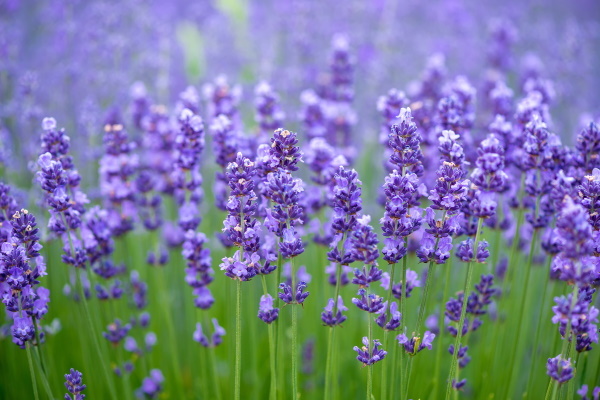
Different ways to use lavender:
- Inflorescence tea - relieves indigestion, aids in the digestion of food.
- A few drops of oil on whiskey - for headaches, migraines, for concentration during mental work.
- In the form of an aqueous infusion of flowers - tones and refreshes the skin.
The complex, interesting scent of lavender is used in perfumery. Essential oil is added to shampoos, soaps, creams, balms. In addition to its wonderful scent, lavender provides excellent skin and hair care.
Lungwort
A beautiful spring plant with bells of different shades is found in forest glades. The scientific name of the flower is pulmonaria. It was named as a lungwort for the large amount of sweet nectar inside the buds. A feature of an early spring flower is the presence of pink, blue, white, purple, pink bells in one inflorescence at the same time.
Medunitsa is used to treat various diseases, but it copes best with pulmonary diseases.
Using Pulmonaria:
- a source of vitamins and minerals - fresh as a salad;
- in case of blood diseases, insufficient work of the thyroid gland - take the juice of the plant;
- with pharyngitis, bronchitis, asthma, tuberculosis - decoctions or tea from flowers.
For skin diseases (including lichen, boils), lungwort is used for washing or compresses, and they also drink infusions to cleanse the blood. This way the healing process goes much faster.
Forget-me-not
The name of the genus, translated from Latin, sounds like "mouse's ear" because of the appearance of young pubescent leaves. However, all over the world, the plant has names that are consonant in meaning with the Russian "forget-me-not" and symbolizes the eternal memory of an event or a person.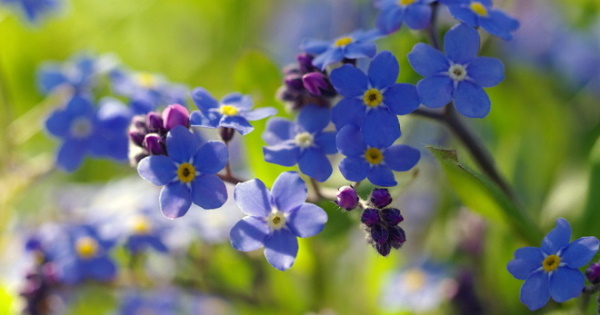
Small flowers always have 5 round, blue petals and a white-yellow eye in the center. The height of the entire plant rarely exceeds 30 cm. Flowers are concentrated at the ends of erect shoots, and large leaves are collected in rosettes near the soil itself. Forget-me-not is an ornamental plant that is grown in temperate climates around the world.
The following medicinal properties of flowers and shoots are known:
- hemostatic (both for external wounds and for internal bleeding);
- expectorant and emollient for violent cough;
- externally, the herb is used to wash the eyes, as well as for eczema or rashes.
There is information about the use of forget-me-nots for snake and scorpion bites. It is often recommended to rinse your mouth with a decoction of forget-me-nots for severe toothache, wounds, swelling in the mouth.
Dandelion
A well-known plant that grows everywhere and is considered a weed. Dandelion seeds attached to white "parachutes" are easily carried by the wind, which helps the culture to spread in any area: along roads, on vacant lots, flower beds, in fields, vegetable gardens.
The perennial plant has a long (more than 50 cm) root in the form of a rod and a small aerial part. First, a rosette of bright green, long leaves with large teeth along the edges grows. Then, buds emerge from the soil on tall stems.
Flower shoots look like a tube, and when broken, they release white, bitter juice. The inflorescence-basket of a dandelion is bright yellow, about 3 cm in diameter, consists of many reed flowers.
The whole plant is used for medicinal purposes:
- fresh leaves are added to salads as a vitamin remedy;
- decoctions and infusions treat cholelithiasis, kidneys, liver, stomach;
- flower jam improves blood formula, saturates with minerals and vitamins, improves digestion;
- the roots contain a large amount of inulin, which is beneficial for diabetes.
The rich composition of dandelion helps to restore strength, gently soothes the nervous system, and helps to resist infections.
Plantain
The name of the herb indicates the property of growing along paths and roads. The seeds attach easily to the soles of the shoes and are thus carried along the paths. The American Indians called the plantain the "white man's footprint." It is believed that the plant came to the continent on the boots of pioneer sailors.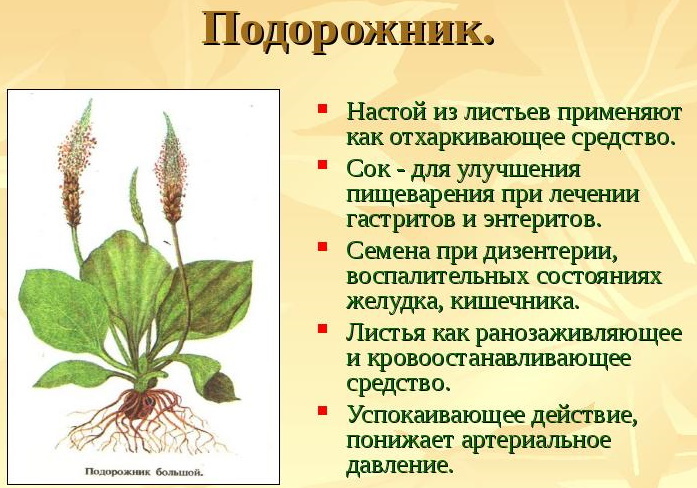
Plantain has large, oval leaves with prominent veins. A spike-shaped inflorescence in the form of an arrow rises from the center of the basal rosette. The tip of such a stem is dotted with the smallest brown flowers, and later seed pods with tiny seeds ripen on it.
The use of leaves for wounds, scratches, abrasions, burns is well known. It is enough to rip off the plantain, knead it a little and apply it to the damaged skin. The plant not only relieves pain, but also draws pollution from the wound, disinfects, and promotes healing.
Plantain herb helps to cure the stomach, all types of coughs, colds and sore throats. The seeds contain many useful substances, so they are used in case of weakness, for recovery from illness, with a lack of vitamins.
chamomile
Medicinal plants, photos and descriptions of which are familiar to everyone. Medicinal chamomile is the most popular remedy in the home medicine cabinet. An easily recognizable small flower with a yellow center and numerous white petals grows everywhere, on all continents, except for very cold regions.
Herbaceous bushes of pharmaceutical chamomile have strongly dissected leaves with thin lobules. Flowers, like suns, densely dot the plant.
Chamomile has a recognizable, strong smell and many beneficial properties:
- chamomile tea soothes the nerves, heals headaches;
- a hot drink with chamomile lowers the temperature;
- infusions and decoctions destroy microbes;
- improve digestion and relieve abdominal pain.
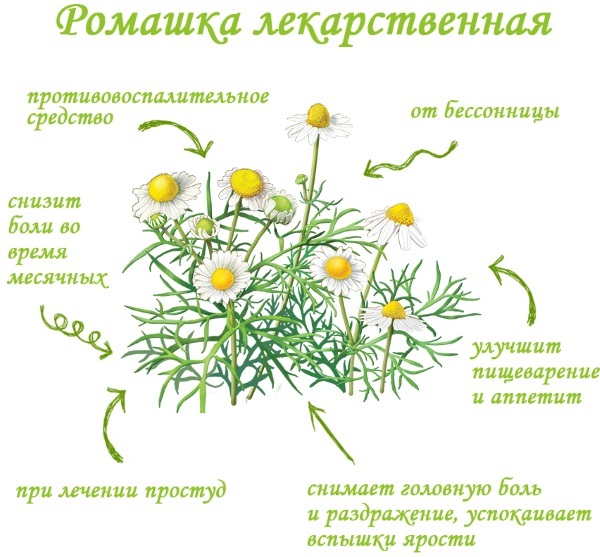 Gargling with chamomile is also useful for colds, sore throats. Chamomile tea is often drunk to strengthen immunity during the cold season or during flu epidemics.
Gargling with chamomile is also useful for colds, sore throats. Chamomile tea is often drunk to strengthen immunity during the cold season or during flu epidemics.
Pine
A coniferous tree capable of growing up to 50 m in height. The needles of the plant are long, hard, growing in bunches. The trunk is most often straight and slender, and the bark is reddish. The whole plant exudes a strong scent rich in valuable essential oils.
Even the air around the tree has medicinal properties. People with lung diseases breathe easier in a pine forest. The fragrance is useful for children and adults, and especially for people with heart disease, chronic, severe diseases.
Pine needles contain a huge amount of vitamins, natural antibiotics, aromatic substances that kill harmful microbes. The kidneys are brewed like tea and drunk with flu, severe cough. The needles are ground with honey and taken as a strengthening, vitamin remedy.
Yarrow
This simple-looking herb has many popular names: White gruel, Bloody grass, Cut grass, Begolovnik. Yarrow plant is named for the fact that small flowers are collected in numerous baskets, and then in large shields at the tops of the shoots. The height of the grass can be very small, but under favorable conditions, the stems grow up to 80 cm.
Many names of the flower speak of its main purpose in medicine - to stop bleeding. Moreover, the action of the herb is very fast. Nosebleeds stop in a few minutes, and with prolonged treatment they can disappear altogether.
Yarrow is also used for such diseases:
- stomach diseases, gastritis, ulcers;
- diseases of the bladder;
- acne or boils;
- external and internal bleeding, including trauma.
Yarrow not only stops blood, but also disinfects wounds. Since the time of Suvorov, the plant has been called the Soldier's Grass. Powder of the dried plant was sprinkled on wounds received in battle, which saved many soldiers from infection.
Celandine
Medicinal plants, photos and descriptions of which should be studied, include an inconspicuous, but very useful herb - celandine. The name speaks of its ability to cleanse the skin. The herb is often used to treat skin diseases, relieve itching, and take baths.
Celandine bushes grow up to 1 meter in height, have straight, erect stems. A white sap immediately appears on the rift, which turns bright orange when exposed to air. The flowers are small, with 4 delicate, yellow petals. The resulting fruits are narrow pods, sticking out vertically in the places of faded buds.
Inside, the herb is taken with great care, in case of serious diseases: tumors, cancer, polyps, tuberculosis. Decoctions and infusions have antimicrobial, antiviral effects. The burning juice of celandine is used to remove warts. The effect of grass on wounds is compared to brilliant green.
Sage
Perennial shrub or herb, recognized by folk and official medicine. Ornamental sage species can be seen in gardens and flower beds. To obtain fragrant oil, the herb is grown on special plantations.
The shrub is cultivated throughout southern Europe, in the Black Sea climate of Russia. Wild sage is found throughout the Mediterranean coastline.
The sage bush has a woody trunk, herbaceous branches, and silvery-green, soft leaves. Inflorescences are erect, spike-shaped. The flowers are bright, blue or lilac. The height of the bushes can reach 70 cm.
The most famous property of sage is cough treatment. Pharmacy lozenges, syrups, sprays are prescribed for any problems with the throat, bronchitis, colds.
Sage herb is brewed as tea and is used for such problems:
- indigestion;
- painful weight loss;
- violation of metabolic processes;
- stress and nervous tension;
- respiratory infections;
- damage to the gums.
Sage decoctions are used externally to treat skin diseases, infected wounds, rashes, irritations, diathesis.
Tribulus
An unusual-looking creeping plant with thick shoots and soft, dissected leaves. Tribulus fruits resemble round thorns and can be attached to clothing, shoes, animal hair. The flowers of the plant are small, lemon yellow.
Tribulus willingly grow on the sand, settling in stony and infertile areas. Perennial grass is more common in the south. In cold climates, tribulus roots freeze out in winter, but the plant can grow as an annual.
The substances contained in the creeping grass make the body clear of poisons and toxins faster. Tribulus tea is used to cleanse the intestines, improve appetite, and treat the genitourinary system. Decoctions of herbs wash the eyes with conjunctivitis, treat wounds, acne, ulcers, and also treat the fungus.
The herb has a strong effect, it can help with some heart diseases, high blood pressure, serious infections. But you need to drink it carefully, following the doctor's recommendations. In addition, the plant sap is very dangerous for animals.
Medicinal plants can help in different situations, cure many diseases, replace vitamin complexes. Photos and descriptions of useful herbs, flowers, trees are easy to find in encyclopedias and on special sites. But the benefits of plants, like any drugs, depend entirely on the correctness of their use. Any medicinal herb can harm if used ineptly.
Videos about medicinal plants
What are and how to prepare medicinal herbs:



